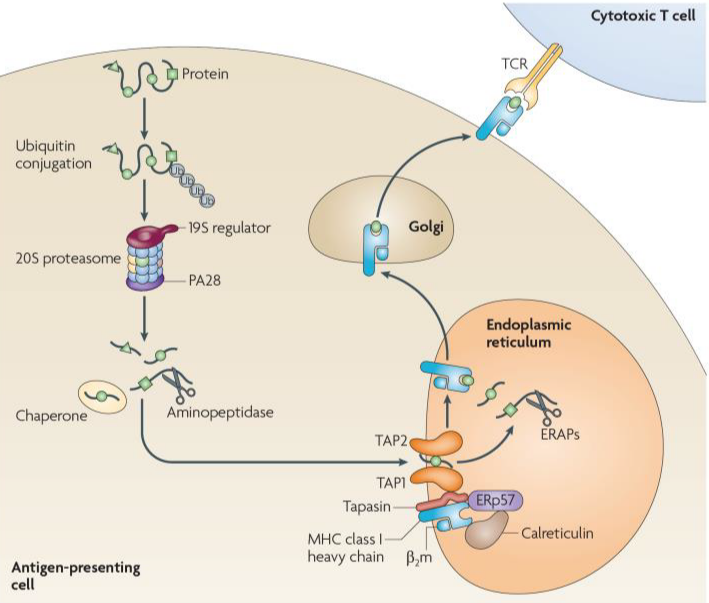The ubiquitin-proteasome system in MHC class I antigen presentation
Antigen presentation on MHC class I molecules allows immunosurveillance of proteins synthesized within cells. Generally, epitopes presented on the cell surface derive from proteasomal degradation of proteins to small peptides. These are subsequently further processed, transported into the endoplasmatic reticulum and loaded to MHC class I molecules.
We are especially interested in studying the influence of interferon-inducible proteasome subunits LMP2, LMP7 and MECL-1 (immunoproteasome subunits) and regulator protein PA28 on the peptidome presented on MHC class I molecules.
Furthermore, we are investigating processes more upstream of proteasomal degradation such as targeting and trafficking of proteins to the proteasome for degradation.

Fig.1: Antigen processing in the MHC class I-restricted pathway. Proteins that are synthesized in the cell (direct presentation) or are released from endosomes (cross-presentation) are polyubiquitylated in the cytoplasm and degraded by hybrid proteasomes consisting of the 20s proteasome core, the 19S regulator and PA28. The peptides that are produced are either of the ideal length for binding to MHC class I molecules (8–9 amino acids) or are amino-terminally extended precursors that can be further cleaved by aminopeptidases in the cytoplasm (such as leucine aminopeptidase, puromycin-sensitive aminopeptidase, bleomycin hydrolase and tripeptidyl peptidase II). Chaperones (such as heat shock protein 70 (HsP70), HsP90α and TriC) can stabilize the peptides in the cytoplasm to prevent their rapid degradation (for example by tripeptidyl peptidase II or thimet oligopeptidase). Transporter associated with antigen processing 1 (TAP1) and TAP2, which are attached to nascent MHC class I chains through tapasin, transport the peptides into the endoplasmic reticulum (ER), where they can be further trimmed at the N-terminus by er aminopeptidase 1 (ERAP1) and ERAP2. The oxidoreductase ERp57 ensures the maintenance of disulphide bridges in the MHC class I loading complex. Note that the carboxyl terminus of a peptide ligand for MHC class I molecules is mainly determined by proteasomal cleavage. The binding of peptides with high affinity to the MHC class I heavy chain–β2-microglobulin (β2m) complex induces a final folding and release of the MHC class I molecule from the ER lumenal chaperone calreticulin to allow exit from the ER and migration through the Golgi to the plasma membrane. TCR, T cell receptor. (Derived from Groettrup et al., Nat Rev Immunol. 2010;10(1):73-8.)
